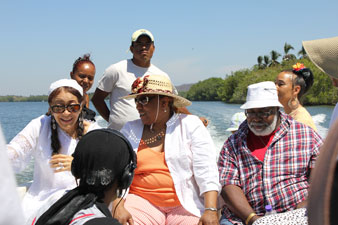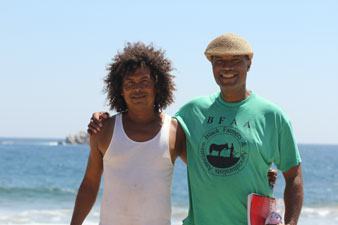MXODUS Tours Invited to Participate in the Encuentro XII (Meeting) Among Pueblos (People), Negros (Blacks) in Mexico, April 16 — April 20, 2010

“Seest thou not that Allah sends down water from the clouds, then We bring forth therewith fruits of various hues? And in the mountains are streaks, white and red, of various hues and (others) intensely black. And of men and beasts and cattle there are various colours likewise. Those of His servants only who are possessed of knowledge fear Allah. Surely Allah is Mighty, Forgiving.”—Holy Qur’an, Surah 35, verses 27-28
Among the outstanding participants on our recent MXODUS Expedition to the Costa Chica region of Mexico was the outstanding Black historian and researcher of our original roots all over the planet earth, Dr. Runoko Rashidi, who addressed a recent letter to the Honorable Minister Louis Farrakhan in response to his experience traveling with us to participate in the Encuentro (Meeting) XII. His letter is recorded in the body of this article to exemplify our increasing love and unity of the Universal Brotherhood.
“Esteemed Minister Farrakhan,
“It gives me great pleasure to take a moment to write to such an esteemed person about such a wonderful experience. From April 14 to April 20 I had the great pleasure of visiting Mexico with a delegation from the Nation of Islam led by none other than Mother Tynnetta Muhammad herself! I have traveled to ninety-seven countries now (indeed, I am in France visiting with my daughter as I write) but had not been to Mexico in more than twenty-five years. In fact, I had only a brief meeting with the descendants of Africans in Mexico before. That week changed everything.
“First, it was an honor seeing Mother Tynetta again. She had come to two or three of my presentations in Los Angeles with her wonderful sister Carlotta Muhammad and she seemed like an extremely gracious and humble person. When she asked me to come to Mexico and lecture in Costa Chica, it was virtually a dream come true.
“Throughout the duration of the trip I was treated with the greatest respect and courtesy. Indeed, I was treated as a very important person by everyone in the delegation but particularly by Mother Tynnetta.

“I have done presentations in fifty-three countries now and have traveled the world numerous times to interact with our sisters and brothers from the Black Untouchables of India to the Aboriginal people of Australia. Nevertheless, Mexico was special. I found the sisters and brothers there with incredibly low self-esteem and what could only be called a strong lack of racial and ethnic pride.
They knew virtually nothing of their history except that they had been slaves. Of their glorious African past and the deeds of our people in the far corners of the earth they were almost completely devoid of knowledge. During our short visit with them we made every effort to change that. And I was so pleased to play a part and make a contribution.
“It is an honor to send this letter, my brother. Just as it was an honor to travel to Mexico with Mother Tynnetta. I must also give the greatest thanks to Sister Callie Muhammad, for whom I have the utmost respect and gratitude.
“Blessings beloved elder. I have tremendous hopes of meeting you and pray that our efforts in Mexico will be repeated throughout the world. The Nation of Islam has earned all of my respect and appreciation.
“In love of our people the world over,
“Dr. Runoko Rashidi
www.travelwithrunoko.com”
The head of the Ministry of Agriculture, Dr. Ridgely Abdul Mu’min Muhammad, also participated in this conference and spoke to the farmers in the region concerning their agricultural problems and methodologies of farming. He issued a report on his findings.
Water and Will: Limits to Growth
During the Saviours’ Day weekend of 2010, Mother Tynnetta Muhammad invited me to come on the MXODUS tour to some small villages on the West Coast of Mexico. It seems that there is a small enclave of Mexicans of African descent who could be helped by some of my agricultural expertise. I said that I would love to come, however, I must first get a clear picture of what the farmers there were already doing and what were the environmental and agronomic constraints for that area. Farming techniques and equipment that may work well in one environment may not work in another environment.
I had to take a lesson from my own book “The Science and Business of Farming vs. The Art and Hobby of Gardening.” In this book I emphasize how you must look at the farm as a “system” and must fully grasp the environment that the farm system must operate under. Successful farming is a matter of balancing forces of nature and human society to obtain a sustainable system. Just because a plant will grow or an animal can live does not mean that an economically viable system can be produced in which the majority of the population is satisfied and the land, water and air is not destroyed.
We arrived in the township of Huehuetan in the State of Guerrero, in the Costa Chica area of Mexico on Friday, April 16th, and I immediately noticed how dry and hilly the land was. The vegetation was dry and a dull green. The animals were thin and emaciated. This was in April where things were getting very green back home in Georgia, but here I wondered about the rain.
The next day I asked local farmers through an interpreter what were their major problems. Immediately they said they needed water and their soils lacked fertility. I noticed that there were a number of capped off wells at homes in the little village. The farmers said that the wells dried up about 15 years ago. The water table has dropped but there is water from 5 to 30 meters underground. It would cost about $6,000 to dig a well, but they had little financial resources.
I also asked them about the rain. They said that they were in the dry season which goes from October to May. However, even during the rainy season 60 to 75 percent of the total rainfall comes in just two months, July and August. When these rains come, they fall in torrents which washes away the remaining topsoil on the hilly slopes.

We compared notes on how to grow different crops like corn, beans and watermelons at our farm in Georgia compared to their farms in and around Huehuetan. Indeed where we might use a bottom plow to turn under weeds in preparation for planting, harrow and smooth the soil, then plant with our tractor driven planters; they just waited for the first rains and pushed the seeds in the wet ground with their finger. At first one my say, well you see they need to come up to the modern times and learn how to grow scientifically. Fortunately, there was a scientist who gave a presentation at this annual “Black People’s Conference” in which we participated.
Mr. Fermin Marinez Hernandez from the Universidad Automa Chapingo specializing in appropriate technology emphasized that because of the hot climate and thin soils American styled farming depending on heavy tractors and the turning up of the soil would destroy the fragile soils in this area. A farmer would want to disturb the thin topsoil as little as possible, because when he exposes lower levels of the soil to the sun, the excessive heat will burn up the organic matter and nutrients in the soil. Therefore the local farmers’ method of sticking a seed in the ground after a rain, waiting for the plant to emerge, then pushing more dirt to the plant as it grows is the “scientific method” to use under their climatic and agronomic conditions.
Dr. Ridgely’s Agricultural Report to be continued.
“Surely those who recite the Book of Allah and keep up prayer and spend out of what We have given them, secretly and openly, hope for a gain which perishes not–That He may pay them back fully their rewards and give them more out of His grace. Surely He is Forgiving, Multiplier of reward.”–Holy Qur’an, Surah 35, verses 29-30











